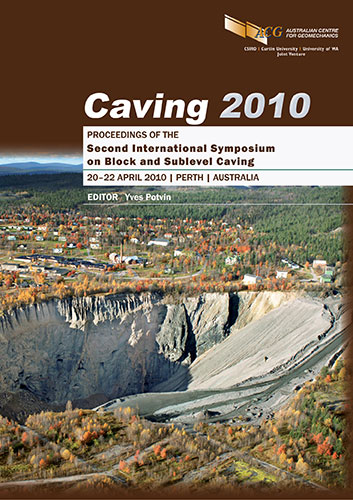Interaction between a propagating cave and an active pit at Telfer Mine — Part II: monitoring interaction

|
Authors: Dixon, RA; Singh, U; McArthur, C |
DOI https://doi.org/10.36487/ACG_rep/1002_22_Dixon-Singh
Cite As:
Dixon, RA, Singh, U & McArthur, C 2010, 'Interaction between a propagating cave and an active pit at Telfer Mine — Part II: monitoring interaction', in Y Potvin (ed.), Caving 2010: Proceedings of the Second International Symposium on Block and Sublevel Caving, Australian Centre for Geomechanics, Perth, pp. 321-332, https://doi.org/10.36487/ACG_rep/1002_22_Dixon-Singh
Abstract:
The Telfer Underground Sublevel Cave (SLC) Operation is located approximately 800 m below the west wall of the Main Dome Open Pit. The Telfer SLC initiated in late 2006 and is caving successfully at a global rate of approximately 0.6 m per day. The cave is expected to break into the planned 5384 mRL bench on the west wall of the active main dome pit which has a haul ramp running along the wall at approximately 70 m horizontal distance from the edge of the cave. The breakthrough area of the pit was being mined as the cave was propagating, requiring assessment of the potential for rapid propagation and unexpected subsidence. Key trigger points for evacuating and barricading the breakthrough area were based on monitoring of cave propagation, calculation of air gap and risk assessment of the interaction. Monitoring of key parameters was critical for informed decision making and safe management of the interaction. Part II of this paper discusses the monitoring systems used to track the cave and monitor the interaction area of the pit. These include deep hole extensometers, seismic array, open hole surveys with video cameras, prisms and a radar monitoring system. The monitoring systems are used to determine the cave shape, location, rate of propagation, potential for air gaps and ground response in the open pit. The extensometer array was buried under backfill used to preload the breakthrough area. This required protection for the instrument heads and cabling to ensure that the monitoring continued to function as required. The monitoring systems are critical for indentifying approaching hazards and taking proactive mitigation measures.
References:
Joughin, W. (2008) Assessment of Seismic Risk, Internal report prepared for Telfer Mining Operations, Newcrest Mining Limited.
Pfitzner, M.J. (2003) Monitoring a blind sublevel cave – A case study of an integrated approach at Newcrest Mining’s Ridgeway Gold Mine, in Proceedings First Australasian Ground Control in Mining Conference, Ground Control in Mining; Technology and Practice, B.K. Hebbelwhite (ed), University of New South Wales, Australia,
pp. 113–122.
Singh, U., Dixon, R.A. and McArthur, C. (2010) Interaction between a propagating cave and an active pit at Telfer Mine – Part I: interaction management, in Proceedings 2nd International Symposium on Block and Sublevel Caving (Caving 2010), Y. Potvin (ed), 20–22 April 2010, Perth, Australia, Australian Centre for Geomechanics, Perth, pp. 307–320.
Watt, G. (2009) Investigation into recent changes in seismicity, Internal communication Telfer Mining Operations, Newcrest Mining Limited.
© Copyright 2025, Australian Centre for Geomechanics (ACG), The University of Western Australia. All rights reserved.
View copyright/legal information
Please direct any queries or error reports to repository-acg@uwa.edu.au
View copyright/legal information
Please direct any queries or error reports to repository-acg@uwa.edu.au